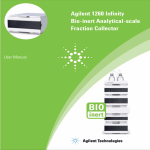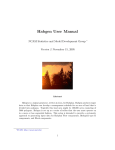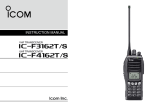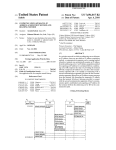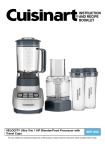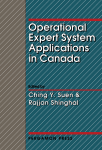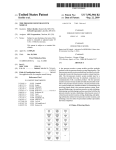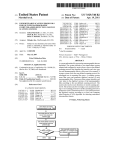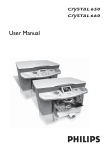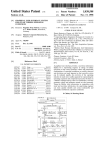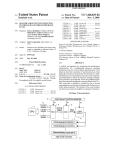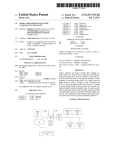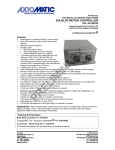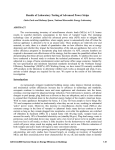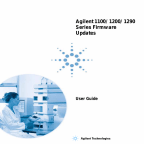Download Scalable integrated tool for compliance testing
Transcript
USOO7890285B2 (12) United States Patent (10) Patent N0.: Manfredi (54) (75) (45) Date of Patent: SCALABLE INTEGRATED TOOL FOR 6,456,955 B1 9/2002 Andrews et al. 6,876,941 B2 * 4/2005 Nightingale .............. .. 702/120 Inventorr 6,978,218 B1 12/2005 Kolb et al. 7,440,863 B2 * 10/2008 Manfredi .................. .. 702/108 Charles Manfredi, Oakhursts NJ (US) _ _ _ 2002/0156757 Notice: 10/2002 Brown .. ... .. 2003/0008648 A1 2003/0084340 A1 100% Bims et 31' 50003 50116112 et al' U_S_C_ 154(1)) by 349 days_ 2004/0109453 A1 6/2004 Wirth Clalmer' (21) Appl' NO" 11/286’198 NOV_ 22, 2005 (65) . . . . .. 707/1 702/120 2002/0192624 A1* 12/2002 Darby et al. .............. .. 434/236 Subject to any disclaimer, the term of this patent is extended or adjusted under 35 This patent is subject to a terminal dis- Filed: A1* 2002/0183956 A1 * 12/2002 Nightingale (U ) (22) *Feb. 15, 2011 COMPLIANCE TESTING (73) ASSlgneez aide“; Technomg‘es’ Inc" sama Clara, (*) US 7,890,285 B2 2004/0128646 A1 7/2004 Jindal et al. 2004/0145598 A1 7/2004 Parent et al. 2005/0071720 A1 3/2005 Dattaram et al. 2006/0041840 A1* 2/2006 2006/0077895 A1 4/2006 Wright Blair et al. ................ .. 715/513 2006/0155411 A1* 7/2006 Khoche et al. ............ .. 700/108 2006/0161836 A1* 7/2006 Thomson et al. .......... .. 715/505 Prior Publication Data US 2006/0247885 A1 Nov. 2, 2006 Related US. Application Data (commued) (63) Continuation-in-part of application No. 11/ 119,255, OTHER PUBLICATIONS ?led on Apr' 29’ 2005’ HOW pat' NO' 7’440’863' I t Cl “Standardization of data 0W for laboratory automation soft on XML technology”, IEEE Xplore, Oct. 2006 , 2 pages. (51) 11 . . G01R 31/00 (2006.01) G06F 11/30 (2006.01) G21C 17/00 (200601) (Continued) _ _ Primary ExamineriMichael P Nghlem (52) U.S.Cl. ..................................... .. 702/120; 702/182 (58) Field of Classi?cation Search ............... .. 702/ 108, ( 57 ABSTRACT ) 702/182,189,120,81,115,117,118; 703/21, See a pp (56) lication ?le for com lete search histo 703/22 p ry' References Cited US. PATENT DOCUMENTS 5,280,617 A * 1/1994 5 841 771 A * 11/1998 _____ from one or more analytical instruments and/or software is inputted, and calculations are performed on the data to pro duce one or more outputs. At least one of the outputs may be Brender et al. ............ .. 717/159 Irwin et al‘ Methods, tools, systems and computer readable media for compliance testing instrumentation and/or software. Data _ _ _ __ 370/360 5,878,383 A * 3/1999 Carter ............... .. 702/182 5,961,448 A * 6,054,865 A * 10/1999 Swenson et al. 600/301 4/2000 Bald et a1. ................ .. 324/551 compared to ?rst and second test _ limits, and compliance status of the at least one output relative to the ?rst and second test 11ml“ 15 rePom/d Input Data in Native Format 37 Claims, 9 Drawing Sheets /“ l l 0 Convert Data to Technology ,4} 20 Neutral Format L_____I@une?99_13_ala_____1 Perform Calculations /“ 1 30 Output Standardized /_1 40 Results US 7,890,285 B2 Page 2 SSI4Chromatography Data System. http://WWW.scisW.com/prod U.S. PATENT DOCUMENTS ucts/cds/indeX2.htm pp. 2, Mar. 3, 2005. 2006/0247878 A1* 11/2006 Manfredi .................. .. 702/108 2006/0247885 A1 11/2006 Manfredi 2008/0059123 A1* 3/2008 Estberg et 2008/0201098 A1* 2008/0215638 A1* al. ............ .. 702/188 8/2008 Manfredi 9/2008 Manfredi . . OTHER PUBLICATIONS “metadata”, Webopedia 2007 , 2 pages. Of?ce Action dated Jan. 29, 2010, in US. Appl. No. 12/150,030 for “Integrated Tool For Compliance Testing Within An Enterprise Con tent Management System”. Agilent4Cerity Enterprise Content Manager (ECM) http://WWW. chem.agilent.com/Scripts/PDS.asp?IPage:16769 pp. 1-2, Feb. 19, 2005. AnIMLiAnalytical Information Markup Language. http://animl. sourceforgenet/ pp. 1-8, Feb. 19, 2005. Microsoft Of?ce Online: Visio 2003 Home Page http://of?ce. microsoft.com/en-us/FX010857981033.ast pp. 1-2, Apr. 28, 2005. FormMaXiE-Forms Software for Business Forms Designing and Filli . . . http://WWW.cutepdf.com/Products/FormsMax/ pp. 1-2, Feb. Agilent4Cerity Pharmaceutical for QM QC. http://wwwchem. 18, 2005. agilent.com/Scripts/PDS.asp?IPage:272 pp. 2, Mar. 3, 2005. Revision of ChemStations PlusiAgilent Technologies http://WWW. Waters Laboratory InformaticsiEmpower TM Chromatography laboratorytalk.com/news/agi//agi134.html pp. 2, Jan. 15, 2002. Data Software. http://WWW.Waters.con?watersdivision/contentd. asp?Watersit:JDRS-5KXPGA pp. 2, Feb. 18, 2005. * cited by examiner US. Patent Feb. 15, 2011 Sheet 1 019 US 7,890,285 B2 Input Data in Native Format /"l l 0 Convert Data to Technology f1 20 Neutral Format ___ l I 155-5155 Data—R-&lu5tion_—_: 1 based on Technology Neutral 1" l 25 L Formatted Data _: _______ __g___*___u_ Perform Calculations /“ l 30 l Output Standardized Results FIG. 1 "140 US. Patent Feb. 15, 2011 US 7,890,285 B2 Sheet 2 0f 9 cow 96RE85:Q892E6mG ma2n6 "Ev2?scbwh (U¢9N"3m5o:ra2t6ome 032 w%-(nogw ( 3 5 H a 2 O 9 5 / 0 onmwé(oOEmN <3(G85a9vu68a:m2 w5.3022-52 <om20 .UEN @QH(wS2@RWE8Q5NU US. Patent Feb. 15, 2011 US 7,890,285 B2 Sheet 3 0f 9 wo?bcm AUI mzswom ooH\ @m .5 ano wowmom \cowm?wc@m8w5 wa 0% .Eggwemcou?suEU o\om gmNEE1/ @wou _\ Q US. Patent Feb. 15, 2011 Sheet 4 0f9 US 7,890,285 B2 100 404/406 / f/J j 408 414 ——> Record Forms Data Storage and Fonnat Converswn a] Q] J 410 Data Reduction / 416 Extract Using /‘ Mining Engine 440 Engine / 48 Automated % Calculation f 412 /* Report 442 Generator Engine q] f 420 Customizable 444 “J FIG. 4 Report US. Patent Feb. 15, 2011 Sheet 5 0f 9 US 7,890,285 B2 Sm .UEm PuEomfzncwae .6:520 ON US. Patent Feb. 15, 2011 US 7,890,285 B2 Sheet 9 0f 9 28Em98@M3chH208o1:62w5 @MN9mm Jm ¢m 6%Ecu.3o8s:?9eo»m m w W82hwmE“5:Q6ai.38Es;2UwQ0M \@?2N3lQ>5o6?%I;T/ $1 a“c?.86#@>on628%:5wv3n2g5 8E2nQ.6vE20%30 E02a30E8m>":8%é5vo3w;2e (i5mN6R5 DMcmE2Hov3V;s$2w8%ma30 \823052:7 ¢N /c06:n\h8m3o>E52g@QwBsza8:;Uun@ 2:8mi2>B“o5#ES.3:6o852w8k<a @2:gm$moviB58?Q2oSc0xE6n9maQt8.E? $B265wm2:822ES5eo6m3?w26.a803 moQ:8W>wn6v8%Mo63:a$2me acQ“EmUo58%M8V;3s§?5vmo RX.“ m o86:32N58%6>hV3:2m5:e mA;3:En6.cdov:2am?e o 1 325W3*W ¢QME“N83N0SE2m wwm_M:cam“2aand~38 ~2535NE6<v80\i:o/5Na2m F/wow 72mg 2T1%“ w(3N6wM)2 aGE US 7,890,285 B2 1 2 SCALABLE INTEGRATED TOOL FOR COMPLIANCE TESTING wherein the one or more outputs are standardized and are directly comparable to outputs resultant from carrying out the method carried on another set of one or more other analytical CROSS-REFERENCE instruments, irrespective of manufacturer or model of the other analytical instruments. This application is a continuation-in-part application of application Ser. No. 11/119,255 ?ledApr. 29, 2005, now US. Pat. No. 7,440,863, which is incorporated herein by reference in its entirety and to which application we claim priority under 35 USC §l20. Methods, systems and computer readable media may com pare at least one of the outputs to ?rst and second test limits, and report compliance status of the at least one output relative to the ?rst test limit and to the second test limit. Methods, systems and computer readable media are pro vided for compliance testing at least one of instrumentation BACKGROUND OF THE INVENTION and software, by inputting data from at least one analytical instrument or software; performing one or more calculations on the inputted data to produce one or more outputs; compar Quali?cation of instruments for regulated markets has tra ditionally followed one of two models: paper-based protocols ing at least one of the outputs to ?rst and second test limits; and reporting compliance status of the at least one output relative to the ?rst test limit and to the second test limit. Methods, systems and computer readable media are pro vided for compliance testing at least one of instrumentation that are run on instruments using the native controllers of the respective instruments; and external calculations or quali? cation routines that are embedded into the controlling soft wares of the instruments, respectively. Some efforts at auto mated data collection have required that an alternative data 20 path be employed for the data collection while still control ling the instrument using its native controller. Examples of proprietary embedded software suites include Cerity NDS or software associated with an instrument to initiate the test (Agilent Technologies, Inc. for chemical/pharmaceutical quality assurance and quality control, and Empower CDS (based on Waters Millenium software, Waters, Inc. These and software, to display a test protocol form on a user inter face and prompt a user to input information regarding a test for qualifying a result of a test; prompt at least one instrument 25 protocol in response to an input by the user into the test protocol displayed on the user interface, or results from another instrument in response to a test protocol run on the software suites are limited to the suite of instruments that they another instrument; automatically calculate results of the test can control. protocol run on the at least one instrument; and output status of the results as determined by at least one set of dual test Thus, even though these suites are pro?cient for producing data and results for quali?cation/quality assurance tasks for 30 the particular instruments that they control, such suites cannot provide standardization of the data types that are processed, nor calculations across controller platforms. Further, data is maintained in a proprietary format that requires the collecting data system to be present and functioning for viewing and 35 reprocessing any data used/outputted by these systems. Recently, an integrated single source of data collection and storage, EZChrom Elite, was introduced by Scienti?c Soft ware Inc. While offering a relatively large driver set, this solution is still limited by the available drivers that are pro vided with the solution Further, all of the current solutions, including those men least one calculation on at least one of the data outputted by an one or more outputs required for a set of prede?ned criteria; 40 These and other advantages and features of the invention reading the details of the methods, systems and computer readable media as more fully described below. 45 BRIEF DESCRIPTION OF THE DRAWINGS different manufacturers, to compile reports thereon. It would FIG. 1 shows a ?owchart of events that may be carried out be further desirable that such a solution provides standard 50 readily used to generate reports using data generated from instruments having different platforms, and/or still other instruments that aren’t included with any established plat 55 instruments from most, if not all manufacturers, to readily prepare reports therefrom and/or otherwise manipulate the data as needed SUMMARY OF THE INVENTION during processing according to at least one embodiment of the present invention. FIG. 2 illustrates one example of a form that may be used forms. Accordingly, there is a need for solutions that are generally applicable for use with data generated/collected by and interactive forms providing procedural information including calculation instructions. will become apparent to those persons skilled in the art upon It would be desirable to provide a solution capable of incorporating data from different instruments, as well as from ization among various data types so that one platform can be of analytical hardware and controlling software during com pliance testing is provided to include: a data reduction engine con?gured to reduce outputted by an analytical or other instrument; a calculation engine con?gured to perform at analytical or other instrument and the reduced data to produce tioned above, as applied to instrument quali?cation, require decoupling of the native system that controls the instrument to be quali?ed, in one fashion or another. limits. A system for standardizing characterizations of at least one 60 by an embodiment of the present invention. FIG. 3 is a schematic ?ow chart illustrating process ?ow according to an embodiment of the present invention. FIG. 4 is a block diagram illustrating functions and pro cesses that may be managed through a business process man ager according to an embodiment of the present invention. FIG. 5 illustrates an extraction of information from a form. FIG. 6 is a ?ow chart illustrating further details of process ?ow by an embodiment of the present invention. Methods, systems and computer readable media for com pliance testing at least one of instrumentation and software are provided for: inputting data from at least one analytical instrument or software performing one or more calculations 65 on the data to produce one or more outputs; and selecting from the one or more outputs to populate a ?nal report; FIG. 7 is a schematic representation of an embodiment of a system for use in creating a compliance report for chromato graphic instrumentation. FIG. 8 illustrates another example of a form used in per forming a test and qualifying test results against dual test limits. US 7,890,285 B2 3 4 FIG. 9 illustrates another example of a form used in per forming a test and qualifying test results against dual test limits. outputted by other instruments, regardless of model or manu facturer. Methods, tools and computer readable media for generating, transmitting and storing forms speci?c for a user’s needs are provided, including, but not limited to com DETAILED DESCRIPTION OF THE INVENTION pliance validation forms. Systems include computers and associated hardware that may be connectable to a network (for intemet or intranet use) that can execute rules for a Before the present systems, methods and computer read able media are described, it is to be understood that this selected form (e. g., one non-limiting example is a form suit able for submission to a regulatory agency such as the FDA). invention is not limited to particular hardware, software, for mats or media described, as such may, of course, vary. It is In one embodiment, a system is provided to perform analyti also to be understood that the terminology used herein is for cal hardware quali?cations. the purpose of describing particular embodiments only, and is Calculations may be performed to answer a series of ques tions relating to one or more performance tests designed to not intended to be limiting, since the scope of the present invention will be limited only by the appended claims. determine compliance of an analytical instrument and/ or soft Where a range of values is provided, it is understood that each intervening value, to the tenth of the unit of the lower limit unless the context clearly dictates otherwise, between the upper and lower limits of that range is also speci?cally disclosed. Each smaller range between any stated value or intervening value in a stated range and any other stated or ware under consideration with a set of prede?ned criteria. Such prede?ned criteria may be criteria de?ned for regulated industries. For example, “prede?ned criteria” include, but are not limited to regulations set forth in the Food, Drug, and Cosmetic Act. Prede?ned criteria are limits and criteria that 20 intervening value in that stated range is encompassed within the invention. The upper and lower limits of these smaller ranges may independently be included or excluded in the range, and each range where either, neither or both limits are included in the smaller ranges is also encompassed within the ance to these acceptance criteria provides documented evi dence of a device’s operation within expectation of intended use. Such compliance is required by law and is listed in the 25 invention, subject to any speci?cally excluded limit in the set according to a user’s needs, such as when dual limits, are limits are also included in the invention. Unless de?ned otherwise, all technical and scienti?c terms used herein have the same meaning as commonly understood by one of ordinary skill in the art to which this invention belongs. Although any methods and materials similar or equivalent to those described herein can be used in the prac 30 tice or testing of the present invention, the preferred methods 35 Forms may be used as built-in records to store data as it The forms are further useable as a basis for generating reports in a variety of formats. However, as reports are changed, the underlying processes (e. g., the forms containing the data from which the reports are generated) stay the same. Basic univer sal forms stay the same, while the data they contain can be used to report in many different ways. The forms may be provided to a user in a “wizard-type” environment (i.e., as a 40 claims, the singular forms “a”, “and”, and “the” include plural referents unless the context clearly dictates otherwise. Thus, for example, reference to “a limit” includes a plurality of such “wizard-type” interface), wherein the user is prompted for simple tasks, the response to which are incorporated into a much larger data product. In this way the user only has to deal with simple, single item tasks, one-at-a time. An enterprise content manager (ECM) may be employed to limits and reference to “the form” includes reference to one or 45 provide a secure platform to manage all data storage, meta data extraction and archival of data. Alternatively, the system may operate independent of an enterprise content manager to The publications discussed herein are provided solely for their disclosure prior to the ?ling date of the present applica perform data reduction, calculations, and output results, as well as other forms-based functions as described herein. One tion. Nothing herein is to be construed as an admission that the present invention is not entitled to antedate such publica provided, for example. occurs, lending to use of the forms for tracking/audit trails. and materials are now described. All publications mentioned more forms and equivalents thereof known to those skilled in the art, and so forth. Code of Federal Regulations under headings Part 210, 211, 820, 58, and 21 -Part 11 as well as other such regulations and guidance as applies. Optionally, criteria such as limits may be stated range. Where the stated range includes one or both of the limits, ranges excluding either or both of those included herein are incorporated herein by reference to disclose and describe the methods and/or materials in connection with which the publications are cited. It must be noted that as used herein and in the appended represent best practices and manufacturers’ speci?cations relating to instrument operation and performance. Compli 50 non-limiting example of an ECM that may be employed is a tion by virtue of prior invention. Further, the dates of publi cation provided may be different from the actual publication Cerity ECM, available from Agilent Technologies Inc. Since dates which may need to be independently con?rmed. the present system. Referring to FIG. 1, data is inputted to the system in its DEFINITIONS an ECM is an enterprise system, it also provides scalability to 55 A “platform” as used herein refers to a support infrastruc ture for acceptance and coordination of tools and applications required to perform a series of related, but diverse tasks. An “enterprise content manager” refers to a system, scal able to enterprise levels, composed of various hardware and software elements that support the secure collection, indexing 60 and storage of electronic objects. able media for processing data outputted by analytical instru are directly comparable with results from processing data ogy neutral format (event 120) so that all further processing is with respect to data that is all in the same format, regardless of which instrument was used to originally output the data in its native format. Data conversion may be performed when the system is associated with an ECM content manager, by the ECM content manager. Alternatively, data may be provided to the system that is already in a technology neutral format, as for example, when an instrument owner converts the output ted instrument data to a technology neutral format, and then Disclosed herein are methods, systems and computer read ments in a standardized manner so that results of processing native format at event 110, for initial conversion to a technol 65 this converted data is directly inputted to the system. Under this option, the system does not perform events 110 and 120, as the data inputted is already in a technology neutral format. US 7,890,285 B2 5 6 As another option, if data cannot be submitted to the system in a technology neutral format and an ECM is not employed, the analog data outputted by an instrument may be received be provided by the system. In FIG. 2, form 200 includes ?elds instructing the following data to be inserted and stored: Instrument Name 202; Other Name 204; Channel Descrip by the system and then converted via an A/D converter to a tion: Split-Splitless 206, Purged-Packed 208, Volatiles Inlet digital signal to be inputted into the system. The digital signal 210; Model Number 212; Serial Number 214; and License may be provided in a technology neutral format, such as a .cdf Certi?cate ID 216. Forms 200 may be run as an applications program interface (API) and, as such need not ever be even visualized by a user of the system when all data ?elds can be format (e.g., AIA, AnDI, etc.) or proprietary formats such as: bxx, pts, raw, .ch or dat, for example. Data reduction may be performed at event 125 by a data reduction engine as automatically identi?ed from the technology neutral format described below, if needed. By performing calculations/fur ther processing (event 130) on technology neutral formatted data or digital signals having been converted from the analog ted data and/or native CDS and populated into form 200 to output of an instrument, with the present system, calculations are thereby standardized, so that results (event 140) are provided to display one or more forms. In a case where directly comparable between data produced by various interface 250 can display form 200 so that a user can interac instruments, models and manufacturers. The standardization is made possible by the system’s ability to convert data from tively select an entry (as in the case of Model Number 212, shown in FIG. 2, where a drop down menu is provided from which the user can select the proper entry) or manually input an entry, such as by typing, cutting and pasting, scanning or some other alternative data entry mechanism that requires intervention on the part of the user. Further alternatively, the complete all data ?elds. Alternatively, or additionally, a user interface 250 may be automatic population of all required data is not possible, user external sources into a technology neutral format, input of data that is already in a technology neutral format, or read proprietary data, which is then data reduced and calculated by 20 common components. Further, this standardization may be applied to data sources manually, semi-automatically (requir ing some manual application) or automatically, and such data may require data reduction, or may be in a ready-to-process form. In this way data that characterizes the operation of 25 instrumentation or controlling data systems can be used for user interface 250 may be optionally used to enter all data required by a form, either as a result of user preference to do so, or because an instrument being considered is suf?ciently old or unsophisticated, so as to lack a sophisticated enough software interface to supply some or all of the data automati the purposes of quali?cation of said device irrespective of proprietary or native format. One non-limiting example of a cally by interfacing with the present system. technology neutral format that may be employed by the protocol that prompts the user to input information regarding present system is referred to as Analytical Information As another alternative, a user interface may display a test 30 Markup Language (AnIML, see http://animl.sourcefor ge.net/) which is an open source, XML-based standard for formatting analytical data. By converting all data to a tech nology neutral format, and then processing the converted data all according to the same protocols, results are generated that are standardized and directly comparable among results for different instruments which may be different models and/or made by different manufacturers. As noted, the computerized data system (CDS) that is in place for operating the instrument(s) to obtain the data on 35 results of a test. In some instances, the test may be automated, wherein the system may prompt one or more lab instruments to initiate a test protocol in response to one or more answers inputted into the user interface by the user in response to questions asked on an interactive form/test protocol, or in response to results from another instrument (e. g., in response to a test protocol designed for that instrument). The system may also provide a report detailing processes and/or instruments that do not comply with selected speci? cations (i.e., a protocol deviation form). 40 which a report is to be generated may be used as direct input to the system. Thus, original data collected for a report may be The forms may be XML based forms that can be directly rendered to a ?nal report (such as in pdf format, or other format suitable for paper documents, for example). Thus, for accomplished using the native controlling software (of the example, forms 200 may be displayed in pdf or some other CDS) of the instrument(s) without the need to go through external analog to digital conversion or other manipulation. As noted, the data collected may alternatively be collected in analog form andA/D converted for input to the system. Origi document format on user interface 250 when part or all of 45 auto detection of calculation engines provided by the system. nal data, which may be preserved for possible reanalysis by the native CDS, may also be converted to an accepted tech nology-neutral format allowing the data to be submitted to a Forms 200 may be left in native XML format and thereby function as storage for the data that they contain. Forms 200 50 single reprocess and calculation engine for consistent reduc tion and processing. By using the native CDS, the present system may also make use of the drivers employed by the When used interactively, forms may be presented to a user according to need and thus, forms that apply only to the instrument(s) under test are presented, thereby reducing 55 delivery complexity and error potential, while at the same time providing audit trails for tracking, since the forms may be saved, as noted above. By converting proprietary data into standardized data (i.e., data having a technology neutral for mat), the system may provide data in a standardized output 60 form. Thus, inconsistent output from instruments can be con verted to consistent input to an engine that can do calculations in a very predictable, standardized way, which is an important and to instruments having different standards/CDS’s as a result of being produced by different manufacturers. Instructions may be instantiated as forms 200 (e.g., see FIG. 2) to provide procedural information, while also func tioning as data repositories. Forms 200 may be constructed in many different ways and presented to have as many different appearances, some of which are dictated by the information to consideration for quali?cation and compliance reports. be displayed/ stored and much of which may be ?exibly designed. The instrument/process type as well as the required input to the form 200 dictates the content and appearance of form 200. FIG. 2 shows one example ofa form 200 which is in no way meant to be limiting, as many different forms may may be further rendered from the XML format to an HTML version for use with a browser. native CDS, thereby further facilitating the universal appli cability of the present system to different types of instruments them are to be interactively ?lled out by a user. As noted, part or all of forms 200 may be programmatically ?lled out from Once native data has been converted into technology neu 65 trally formatted data, or, alternatively, after converting analog signals outputted from an instrument to digital signals, or after receiving digital output signals from an instrument, US 7,890,285 B2 7 8 metadata may be created by data reduction engine 302 (FIG. 3) of the system 100 so that algorithms from the instrument’s data, etc.). With respect to data reduction and calculation, the results may be standardized and independent of the originat 10 system(s) do not need to be relied upon, and this further ensures standardization of results. For example, for applica tion to chromatography, the present system does not rely upon the software 12 running the chromatography instrument 10 ing data-system or controlled instrument, as noted above. Reports based on those results are fully customizable, as reports ranging from simple summary reports to traditional, fully described compliance protocols may be outputted. from which the raw data is generated to determine what is a peak in the data or where to de?ne the location of that peak, as such determinations are made based upon calculations and The library can be modi?ed, typically added to, to increase functionality, but it does not have to be a different library based on the data system that the instrument used, contrary to algorithms run by the data reduction engine 3 02 of the present system. Data reduction engine 302 reads the data having been converted into technology neutrally formatted data, or other wise, and converts this digital representation of an analog function into data representing features described/character same applies to other calculations, such as those determining what is currently required. Consequently, calls become con sistent and calculations become reusable and portable. For example, a library may be created to calculate peak precision, signal-to-noise, etc., and library 304 may be built to accept only consistent input forms because the input format will always be the same, since the engine for extracting data (data reduction engine 302) will always be the same. Running and/ or ?ltering noise levels, etc. Using this approach, consis processes in this way provides consistent metrics across all tent results are determined for data across the board, whether a particular type of instrument 10 was manufactured by one or 20 manufacturers, types and models of instrumentation. For example, peak detection and baseline evaluation can be per formed as de facto standards against which all systems/in 25 able and portable, being applicable to calculation of the de?ned data speci?cations based upon data inputted from the data reduction engine 302, and wherein data reduction engine 302 may be applied to data from any applicable instrument for ized by the data (e.g., peaks, noise, gradient steps, etc.). The another particular manufacturer, or whether the instrument 1 0 is a different model than another, both of which data is being struments may be evaluated. Thus, such a library 304 is reus processed from. As one example, signal data from a chromatography instru ment 612, as inputted to system 100 by the native controlling software for the instrument is just a series of changing signals over time. Reduction engine 302 converts these signals which it makes sense to calculate the prescribed speci?ca tions, since the data from the instrument will have been con verted to a technology neutral format that the data reduction (which may or may not have been converted to a technology neutral format into useable data, e.g., peak area, noise calcu lations, etc.iwhich can be fed to calculation engine 306* e.g., there are 5 peaks and those 5 peaks have peak areas of 2, 2.1, 1.9, 2 and 2 and the mean is X, with standard deviation of engine 302 is con?gured to receive as input. 30 personnel will no longer need to be trained for operating with regard to each different piece of equipment, but can instead be Y, etc. so that these values can be compared to an acceptance standard, or with like values calculated with regard to another instrument 612. Depending upon the instrument that has generated the data, trained to run the standardized processes. For example, under 35 a data reduction engine 302 may not even be needed. For example, a balance already outputs data that is reduced to numbers that are useable by calculation engine 306 and so this data does not need to be further reduced, although it may be converted to a technology neutral format. Further, other alter native reduction engines 3 02 may be included with the system 100 as part of a library that may be accessed for non-standard reduction requirements. By performing data reduction with a component of system 100, this separates reliability on each instrument’s software for performing such functions. Accordingly, all data reduction is standardized across reports that are prepared by system 100, and performance is all stan dardized by evaluation by the same system. Further, since the data is standardized, only one method need be developed to produce a particular type of report based ating in various locations under multiple (e.g., three) different purposes, it might then be necessary to replicate the compli 40 45 50 55 set produced by data reduction engine 302 for formulating standardized results 308. Calculation engine 306 performs converted to the technology-neutral format, as instructed by forms 200, such as for the performance of quali?cation ser vices on analytical instruments as well as other instruments. As noted, forms 200 may act as instructions for processes carried out by calculation engine 306, as well as for data 60 data has been converted to a technology neutral format, the back end processing is consistent (e.g., processing by data reduction and calculation engines, etc.). Library 3 04 typically ized tasks in the back end processing (e.g., calculation/iden ti?cation of peaks; calculation of statistics describing the software of the particular instrument upon which reports are to be generated. In this way the system is readily adaptable to new/various hardwares as well as softwares, given the generic nature of the protocols. As noted, system 100 may further employ a calculation engine 306 to perform calculations on the reduced metadata calculations on metadata in the reduced metadata set received from data reduction engine 302 as well as any calculations that may need to be performed on other data that has been ogy neutrally formatted data) received by data reduction engine 302, these data sets can be properly manipulated with contains a set of calculations forperformance of the standard ance procedures as many times as there are multiple plat forms. By providing the present system as built on an inde pendent platform, it is not dependent upon the operating on the data, as opposed to the current need to create a method a single consistent method. Thus although the method for acquisition of data may vary depending upon the computer data system from which the data is being acquired, once that conditions prior to the present invention, it would not be unusual for an instrument (piece of hardware) 10 to be oper proprietary operating software platforms. For compliance for each instrument that employs a different data type or format. Thus, calculation engine 306 can perform calcula tions based upon a single library 304 (e.g., series of calcula tions tailored to a speci?c type of report for a particular type of data reporting). For consistent raw data sets (i.e., technol The standardization of processing will advantageously reduce training requirements for operating personnel, since storage repositories of the results of these calculations. Forms 200 can contain any combination of input types including interactive manual input, information detected by software of system 100 and/or the CDS of the instrument being consid ered and/ or calculated reduced data. Forms 200 may further include launch points for executables that perform detection, 65 calculation, or any other function called for by the process. Forms 200 may be version controlled and stored as record of the data collection process leading to a resulting ?nal report. US 7,890,285 B2 9 10 In this way the stored versions of forms can serve as an audit through descriptions of all six sound systems options in the trail from the time of initial collection of the data all the way through to the time of the issuance of the ?nal report. When standardizing all data to a technology neutral format and creation of metadata from the same, calculations by cal culation engine may be carried out by calls to a consistent and tested library, as the calculations are reusable and portable. In order to manage data storage, metadata extraction and archival of data, as well as compilation of ?nal reports and user’s manual until the matching sound system is found. An automated report application for owner’s manuals would pre pare this user’ s manual based upon the options chosen by the owner, so that when the owner looked up the description of the sound system, only one sound system would be described in the owner’s manual, i.e., the description for the sound system actually selected by the owner for his/her car. The automatically populated forms 200 as well as the ?nal other form management functions, system 100 may employ report 444 may be stored into ECM 404 when an ECM is employed, so that ECM 404 is the location of the initial collection, calculation, meta-data and ?nal data, as well as audit trails. Thus, system 100 may include a relational data base with tools such as data reduction engine 302, calculation an enterprise content manager (ECM) 404, as noted earlier. ECM 404 may provide a secure platform on which to manage the functions described. FIG. 4 illustrates a ?owchart of func tions and processes that may be managed by ECM 404 via business process manager (BPM) 406. BPM 406 manages ?ow so that data storage and format conversion (to a technol ogy neutral format) are carried out by ECM 404 at event 408, engine 306, and record mining engine 440, for example, sitting on top of it. Reports 444 can take on any form, and may be selected by followed by reprocessing/data reduction by data reduction engine at event 41 0, functions of which were described above. Further calculations are carried out by calculation engine 306 at event 412, which may be based upon instructions contained in forms 200 and the data populated into form 200 may be recorded and stored in ECM 404 at event 414. The record forms 200 may then be data mined at event 416 by record mining engine 440 to extract speci?c items of data/metadata a user. For example, a report may be created in summary form or in full detail, with or without a logo, etc. While the reports 20 provided, as noted above, whereby the user is provided with selectable choices, via user interface 250, to determine the 25 that are required to populate a ?nal report. FIG. 5 illustrates data extraction from a form 200 to obtain information needed for preparing a report, wherein a portion of a record form 200 is shown from which a particular data entry 502 is located. Record mining engine 440 may employ toolsets for mining data, e.g., name-value pairs may be taken from forms 200 and calculation engine 306 may further extract those values needed by identifying such values based upon the names associated with the values in the name-value pairs. Data from a form 200 can be calculated and the result ing calculations may be returned to the same form 200 or to another form 200 as needed for purposes of organization, Audit trails may be automatically provided by the metadata 30 stored as forms 200 by ECM 404, as alluded to above. Further BPM 406 may provide e-mail noti?cation, scheduling and review, electronic signature functions, etc. Referring now to FIG. 6, a ?ow chart that further explains process ?ow by a system employing an ECM 404 and BPM 35 406 is shown. As noted above, a user interface may or may not be needed, which may depend upon the choice of the user, the types of instruments being reported upon, and/ or whether the system is capable of fully automatically obtaining all infor As shown, forms 200 actually do contain the information/ An automated report application (automated report genera tor) 442 may be optionally included, and if used, functions to format of the report 444 to be produced. Thus, depending upon the selection made, different groupings of metadata from the underlying forms 200 are selected and combined into a format of the ?nal form selected. readability, clarity, etc. data received from the software of the instrument being con sidered, and that data can be mined to ?ll out automated report applications or otherwise to ?ll out a ?nal report 444. In this way, forms 200 act as a repository that canbe mined in various ways4compliance, asset management, etc. Once a ?nal report 444 is signed, however, the data that was mined to ?ll out the ?nal report document 444 can no longer be changed, ensuring inviolable metadata, so that an effective audit trail is maintained. 444 are customizable, the underlying forms 200 created by the system 100 do not change so that standardization is pre served. Auto-documentation feature 442 may be optionally mation required to generate a ?nal report. System control 40 API’s 602 are provided for running processes so that there is not a need to display the process on user interface 250. The 45 business process manager (BPM) 406 permits ?exible for matting of process. For example, the process can be changed just by changing/rearranging a ?ow chart similar to that which is shown in FIG. 6. For example, ?ow charts used may be ?ow charts produced by Microsoft Visio e.g., see http:// o?ice.microsoft.com/en-us/FX0l0857981033aspx, or other alternative chart building software that allows ?ow charts to be readily modi?ed interactively. Such chart building soft 50 wares provide a visual manifestation of a process imple automatically populate documents at event 418 which are mented and controlled by BPM 406. As a simple example, if then outputted as a customizable report 444 at event 420. a current process ?ow of system 100 includes a process or Automated report generator 442 is an application that facili tates that construction of con?guration-speci?c documents from a library of all possible con?gurations. Automated report generator 442 allows documents to be populated with content learned through many various mechanisms, such as the mechanisms that have populated forms 200. An analogy to one function of the automated report application 442 is subprocess de?ned by steps A>>B>>C>>, but the current user/client requires step C to be performed after step A and 55 before step B, then the current process chart can be interac tively rearranged, such as by dragging step C between steps A and B and dropping it there to result in a process/subprocess with reference to an automobile and an automobile user’s 60 de?ned by the steps A>>C>>B. Accordingly, the system 100 provides a great amount of ?exibility for customizing the process control, which is then managed by BPM 406 using manual that accompanies the automobile. Because the owner forms-based process management 604 as was described ear will typically have many options from which to choose from, lier. the owner’s manual is typically written to describe each of these options. Thus, for example, if an owner has a particular type of sound system, but there are six different sound system options for the owner’s car, in order to access information about the sound system, the owner will typically have to page client’s or manufacturer’s data system (i.e., Instrument’s Data System 606) to be fed into ECM 404. Accordingly, any type of instrument, model of instrument or manufacturer of an The technology neutral design of system 100 allows any 65 instrument may be included as instruments 612 from which US 7,890,285 B2 11 12 data can be received by system 100. For example, Instrument 1 may be a liquid chromatography/ gas chromatography instrument 612 produced by a ?rst manufacturer, Instrument 2 may be a liquid chromatography/ gas chromatography instrument 612 produced by a second manufacturer, Instru ment 3 may be still another liquid chromatography/ gas chro matography instrument 612 produced by a third manufac Such reduction provides checks on the interplay between the hardware and software of a system to be quali?ed at each quali?cation event without burdening the hardware quali? cation event with data reduction evaluation of the native CDS. This assures that the more frequent requirements for hard ware quali?cation provide the maximum value with respect to CDS veri?cation, without forcing extensive CDS evaluation. Further, the controlling system (CDS) need not be quali?ed turer, Instrument 4 may be a mixed vendor system, Instrument 5 may be a refrigerator with an embedded microprocessor or for use in the qualifying of hardware, since it is not used for other associated hardware/ software con?gured to input data to system 100 (or alternatively, data from this instrument may be manually inputted via interface 250 if Instrument 5 is not suf?ciently automated), and Instrument 6 may be a centri calculations on the raw data produced by the instrument (after conversion to a technology neutral format, if necessary), such purpose by system 100. Rather, system 100 performs thereby taking the instrument’s controlling software out of the loop and effectively separating the instrument’ s hardware, fuge, wherein the same considerations apply as described with regard to Instrument 5. A “mixed vendor system” refers to systems produced by more than one manufacturer/vendor. Examples of mixed vendor systems include, but are not lim ited to: a computer data system manufactured by a ?rst vendor and controlling an instrument manufactured by a second ven dor; a computer data system produced by a ?rst vendor that from the associated software, so that the report can focus on the hardware, independent of qualifying the instrument’s controlling software. The modularity provided by system 100 facilitates modu lar instrument quali?cation after repair. The process ?ow 20 manager 406 may present forms speci?c to the tests associ ated with the requali?cation of a module. The resultant data can be associated with the module, stack and existing com pliance documentation to requalify the module. Thus, if a module needs to be repaired, then that module can be requali 25 ?ed, rather than having to requalify the entire system, i.e., controls instruments produced by second, third and fourth different vendors; or a computer data system produced by a ?rst vendor and controlling a single instrument made up of components produced by different vendors, etc. As long as the associated computer data system can successfully drive the mixed vendor system, the present system can process the quali?cation may be done on a modular basis. BPM 406 may control the work?ow from collection of data data in a manner as described. through approvals/ signatures of ?nal report 444, and may be tightly integrated into ECM 404. The entirety of processing As noted above, if the instrument’ s data is proprietary data, the proprietary data may be converted to technology neutral may be web browser-based or terminal servers-based so that formatted data, (e.g., AnIML, etc.) using data system control API’s 602 (or, if provided in human readable form, the data may be added to the forms manually and included into quali ?cation processing with any required calculations, or may be converted from an analog signal outputted by the instrument to a digital signal inputted to the system) and both the propri etary data and the converted (technology neutral, A/D con verted, and/ or manually inputted) data may be saved in ECM no footprint is imposed upon the user’ s quali?ed computer. In instances where ECM 404 has been incorporated into a cus tomer’ s system, local interfaces (e.g., user interface 250) may be employed. 35 compliance report for chromatographic instrumentation. Sys tem 100 is represented as interfacing with native CDS to 404. The data can then be further processed by data reduction engine 302, calculation engine 306 and reporting engine 608. receive data inputs. In this example, the equipment being 40 Reporting engine 608 requires at least one of a data mining application (e. g., record mining engine 440) or a middleware component con?gured to provide an input ?le to reporting engine 608 to correctly populate a report. Once ?nal report 444 has been generated, BPM 406 can direct reviews and signatures electronically at event 610. The ?nal report, both signed and unsigned may be stored in ECM 404. Further, all intermediate forms 200 and the data that they 45 store may be stored in ECM 404 to maintain a complete audit 50 Typically, however, a common data system controller (CDS) is provided to control all of the mixed vendor modules, as BPM 406, in which case forms 200 may be presented to a user that functions similarly to the inbox of an e-mail service) are presented to a user of system 100 for forming a compliance FIG. 6 may be based on forms and the instructions contained ing capability may be provided by the forms designer appli 55 anything that is currently available in the market. task can be emailed or placed into inbox 706. At event 708, quali?cation to be performed. In response to this choice sys The data path that the instrument 612 uses is the same data such calculations. This effectively reduces the native com puter data system (CDS) to a controller and data acquirer. report. For example, simple instructions can be provided in a “wizard” like environment (i.e., where simple tasks are com pleted sequentially and interactively). Thus, if a message is placed in inbox 706 that instructs a simple task to be per formed, once the task is performed or “Done”, then the next whether or not BPM 406 is employed, a user, or manager assigning tasks to a user, may choose the type of test or uct of these methods, providing a clear differentiator over be employed for performing calculations. Advantageously system 100 provides everything that is needed for performing noted above. Forms 200 (which may optionally be driven by by placement into a user-speci?c inbox, e.g., BPM Inbox 706, therein. WYSIWYG (“what you see is what you get”) author path that system 100 uses for reports such as compliance. However, the calculations performed on the data for whatever report is to be produced, do not need to be performed on the instrument itself, nor does the instrument’s software need to reported on is mixed vendor equipment 612, in which case, any or all of the vendor’s computer data systems 704 may be employed through which data is inputted to system 100. trail, as was also discussed. All processing represented in cation for designing forms 200. Secure data handling is ensured by ECM 404. Standardized results are the end prod Referring now to FIG. 7, a schematic representation of an embodiment of system 100 is shown for use in creating a tem 100 may then run a template to call the correct forms to be 60 completed for the chosen test. Con?gure stack 710 provides a con?guration-speci?c template which determines the required tests, forms and instructions to be processed. Forms for Instruction 712 are one option for processing, herein these forms 200 associated with a quali?cation event may contain 65 simple instructions for processing with no data entry poten tial. Forms for Acquisition Process 714 provide another option for processing according to forms associated with a US 7,890,285 B2 13 14 quali?cation event in which forms 200 may describe the setup of the native data system to perform speci?c runs and acquire speci?c data from the instrument and/or software to be quali ?ed. Those same forms 200 may provide controls for entry (which may be manual and/or automated) of the results forms 200. Calculation engine 306 may mine forms 200 that have been populated by the reprocessing by data reduction engine 302, or may obtain data from mining results based on matching names to name-value pairs as described above, perform the instructed calculations, and, together with the reprocessed data, output metadata 730, which is chromato graphic metadata in this example. This processing may also obtained from the processes run with respect to the native computer data system to obtain the speci?c data. Forms for Manual Entry 716 are forms 200 in which manual entry may be made directly to. Alternatively, entry may be made to these forms 200 via an application supplied user interface when be API driven, so that all processing may be carried out in the background, without interrupting a user for interactive input. 10 required by a system being tested. Manual data 718 refers to However, even if all the automation cannot work as intended, (such as when an instrument lacks adequate soft ware or other capability for automatically interacting with system 100, for example) then system 100 may launch user a further embodiment of forms 200 that may be created such that form elements are present to allow manual, interactive entry of data from an attendant user. Forms 200 may also be interface 250 to accept some interactive input from a user, constructed as a mixed model where some elements of the under guidance of a standard operating procedure, so that the forms 200 are automatically ?lled in when the data is avail able to the system. When data is not available to the system for user can interactively choose information to be ?lled in. Even the calculation engine 306 is designed to work as an API, as noted. However, a user interface 250 may also be provided for automatically ?lling in the forms 200, such data can be inter actively ?lled in (manually) by a user. Compliance auto detection engine 720 may be an applet calculation engine 306 to allow a user to use it as a custom 20 calculator, for example, so that the same results can be manu very similar to calculation engine 306 that stores or accesses ally calculated, through interface with a user, since the cus identifying characteristics regarding various types, manufac tom calculator uses the same engine 306 that the automated turers, etc. of equipment. So for example, where a form client uses. requests a model number and serial number of an instrument 612, rather than requiring a user to manually enter this infor mation, autodetection engine 720 queries the software 704 associated with the piece of equipment 612 to obtain the required information and then automatically enters it into the form 200 from which the request originated. If autodetection engine 720 is unsuccessful in automatically retrieving some 25 (ies) depending upon the particular instrument from which data is being obtained. Examples of metadata entries that may need to be entered manually include, but are not limited to results of data collected from a source other than the data 30 or all of the information that was queried for, system 100 leaves the entries for this information on the applicable forms 200 blank and presents the forms for manual completion in Data storage and format conversion of the inputted data may be performed by system 100 (optionally, by ECM 404 as controlled by BPM 406) in accordance with the instructions contained in forms 200 selected for processing the data, wherein forms 200 identify the particular data that is needed. In this example, data may be converted to AnIML formatting autodetected data 722 and metadata 730 are mined for the speci?c data required by the ?nal report 444 to be created 35 AnIML format as well as in the native CDS format. Analog data from an instrument may be A/D converted into a stan dardized format 724' for use by the system 100, such as AIA or Native EZC format or other compatible input format to master ?le 734, from which the automated report application 40 such forms. Further alternatively, a ?nal report may be com 45 piled by mined data that is simply assembled and attached to the forms 200 containing metadata. Everything between the raw data (e.g., original data received from an instrument or instrumentation software) and the ?nal reported values is 50 considered metadata. Metadata may be raw data or mined data or a combination thereof as it is used to populate a form. Some pre-?nal data may already be provided on a form while additional pre-?nal data may need to be added by the process. In any case, once the data is converted, data reduction The data on the forms 200 can all be considered metadata in the sense that it is used to create the ?nal report data so it 55 be guided by BPM 406, as noted above). Reprocessing/data reduction calculations can be can be driven by API, so that no user interface is required (i.e., No-GUI Reprocess 728). Thus, data can be inputted directly from an instrument’s operating renders the ?nal document 440. Alternatively, an automated report application need not be implemented. For example, ?nal reports 732' may be embod ied by completed forms 200 without the need to data mine reduction engine 302, for example. engine 302, (whether integrated to ECM 404 or standalone) may perform reprocessing of the data in accordance with the needs of the ?nal report to be generated, as instructed by the forms 200 that need to be ?lled out (and which may optionally (such as by using record mining engine 440), and the mined data may be forwarded to an automated report generator application 442 that assembles the mined data into an auto mated report input ?le 732 which is forwarded to an unparsed 724 or other common data form (CDF), such as AIA (Ana lytical Instrument Association) or ANDI (Analytical Data Interchange) format (typically annotated with .CDF exten sions). When converting to AnIML, Native Data AnIML package 726 may be employed to provide/ store the data in the source provided by the native CDS, such as readings from onboard sensors, readings from external measurement devices, etc. Forms 200 that contain the manual data 718, addition to the automatic generation (autodetected data 722) to whatever extent was possible. Any or all of the manual data 718, autodetected data 722 and metadata 730 may require some additional manual entry 60 software 704 to instrument 100 where it may be converted to quali?es as data about the ?nal report data. In instances wherein BPM 406 is employed, BPM 406 may then forward the ?nal document, such as via e-mail, for example, to have the ?nal document (which may be in pdf format, as in the example shown in FIG. 7) signed. Altema tively, the ?nal document may be manually forwarded by a user, such as by the user emailing or otherwise forwarding the a technology-neutral format and then fed directly to data ?nal document. The ?nal report cannot be modi?ed by those reduction engine 302. reviewing it, but must be reprocessed by the system 100 if The reduced/reprocessed data is forwarded to calculation engine 306 (in this example, calculations are performed for a compliance report, and engine 306 is referred to as a compli ance engine) for further calculations that are instructed by changes are to be made. The process ?ow for such a rerun or 65 re-evaluation involves returning the process to the step that begins processing the information that is desired to be re evaluated. However, if this is not done, then any changes will US 7,890,285 B2 15 16 still be captured by system 100 (or by ECM 404, if used) through its automatic audit trails functionality. Further, BPM needs. A stack, for example, may include all of one type of instrument, different vendors’ instruments, or any combina tion of instruments, as the complexity of the stack can be programmed into an instrument con?guration master form 200. Instrument con?guration master forms 200 may be lim ited to only those instruments and vendors that are con?gu ration master approved, to prevent a user from arbitrarily 406, together with ECM 404 may track the review process and store records of the same to maintain the chain of the audit trail. The ?nal report 440 is thus a defensible piece for use in meeting compliance regulations. Forms 200 provide the basis for processing data by system 100. Wizard-like central data collection may be provided wherein either the automated client or a user are provided attempting to add an instrument to an instrument con?gura tion master form for which there is no procedure for process with simple tasks to complete by ?lling in the appropriate ing. Using the methods and systems described herein, non data, which may require a user to type in, scan in, select, or otherwise enter data, or which may require the automated client to query the instrument’s software for the data which is then inputted to the form, or to perform calculations on select vendor speci?c instrument quali?cations may be processed using a native controlling software of an instrument com bined with a technology-neutral, standardized, post-collec technology neutral data having been converted from the tion data reduction and reporting model. Such processes may native data received from the software of the instrument, or be provided by universally applicable, scalable, automated, other processing as instructed by the particular task presented secure and consistent platform for the development, and by the form. In their most basic con?guration, forms 200 are provided to generate a customer deliverable, typically a ?nal delivery of instrument quali?cation. Original data collected for the quali?cation may be accomplished using the native report containing speci?cally requested or required data. Thus, forms 200 with standard defaults may be provided to automatically generate such a ?nal report. Further, forms 200 stored in ECM 404 may be con?gured to function to provide an audit trail (such as by storing ver sions of the forms as they are completed, together with data and time stamp, for example). Further, forms 200 may be con?gured to contain instructions for all processing by sys tem 100. For example, certain forms 200 may contain speci?c instructions for calculations to be performed by calculation engine 306. Thus, forms 200 can be interactively ?lled out by 20 25 controlling software without the need to go through external analog to digital conversion or other manipulation. However, the system 100 is not precluded from using alternative data input methods, including, but not limited to data that has already been digitized; manual input of data, etc., as already noted above. Original data may be preserved for possible reanalysis by the native controlling software, and may also be converted to an accepted technology-neutral format allowing the data to be submitted to a single reprocess and calculation 30 engine for consistent reduction and processing. Instructions may be instantiated as forms, which may provide procedural a user through user interface 250, and/or can be programmati information as well as act as data repositories. Forms may be cally ?lled out by autodetection processes or calculation presented according to need and apply only to the instrument engines. under test to reduce delivery complexity and error while Various combinations of forms 200, automation and cus tom reporting may constitute a ?nal report by system 100. For providing audit trails for tracking. 35 ?nal product. By adding the automated calculation engines, ing test speci?cation and report de?nitions in making quali ?cation protocols. Each protocol may contain tests, with set points and limits, required to be executed on any single instru 40 such as data reduction engine 302, calculation engine 306 and records mining engine 440, for example, processing may be fully automated to provide a ?nal report, if only according to 45 include, but are not limited to: accuracy and stability of col umn temperature; wavelength accuracy; signal noise and whereby a ?nal report 444 can be customized. Note also, that the modules need not be combined as described, or in the order as described. For example, forms 200 may be combined only with automated report application 442, so that a ?nal report 444 generated from manual inputs to forms 200 may be ment or named group of equipment. Although FIG. 8 shows an example of a form 200 for testing ?ow accuracy and precision of solvent ?ow rate in a liquid chromatography apparatus, other tests/ forms that may be included in a quali ?cation protocol for such a liquid chromatography apparatus a defaulted form of the ?nal report 444. Adding the autodou mentation application 442 provides further ?exibility, FIG. 8 shows an example of a form 200 that may be pro vided for qualifying equipment, and may be used for record example, forms 200 alone may be interactively ?lled out by a user to prepare a ?nal report. Using ECM 404 together with forms 200, forms 200 along with the ?nal report 444 may be centrally stored and provide an audit trail for support of the drift; injection precision and carry over; response linearity; solvent gradient composition accuracy, stability and linearity; and sample temperature accuracy. Of course, quali?cation by 50 customized using the automated report application 442. the present system 100 and forms 200 are not limited to liquid chromatography apparatus, but may be applied to other instrumentation, softwares and hardwares, as indicated Further, a hierarchy of forms 200 may be provided for more ef?cient completion of forms 200 during processing. For above. A default list of tests, set points and limits may be example, a master form may be set up to feed other process provided for each type of quali?cation and instrument that may be quali?ed by the system 100, using recommended forms. A master form generally contains information that is globally the same with respect to all process forms that it 55 tests. The default set of tests may be accepted by a user, or a user-selected set of tests, optionally with user selected set feeds. Accordingly, this permits global information to be ?lled out only once, after which is automatically appears in all of the subordinate forms 200 fed by that master form 200. Different types of master forms 200 may also be created. For example, a quali?cation master form 200 may contain global tings can be used for a custom con?gured quali?cation pro cedure. 60 While FIG. 8 is described with reference to a ?ow accuracy and precision test, it is noted that common features that apply information such as customer information (address, names, to forms 200 for other quality tests are described here. The test etc.), instruments that a quali?cation will be covering, and/or acceptance limits for instrument categories. An instrument name 222 is typically provided by the system, although, for custom-designed tests, form 200 may allow editing of the test con?guration master form 200 may contain a named con?gu ration mapped to con?guration details (e.g., a stack of instru ments 612) and/ or override limits for speci?c equipment 65 name 222. A brief test description 224 may also be provided. Field 226 may be manipulated by the user to run the identi?ed test (i.e., “Run”, as shown), or to omit running this test, by US 7,890,285 B2 17 18 toggling the ?eld to “Don’t Run”, for example by selecting case, passes the quali?cation, but may not meet internal stan dards. Or this may alert the user that the instrument, although button 227 to visualize a drop down menu from which to select either “Run” or “Don’t Run”. The customer reference ?eld 228 allows the user to input a description tailored to the need recalibration and/ or repair soon, since it failed the more user’s needs for easily identifying/describing the test that is stringent limit. currently passing, should be tested more frequently, as it may being performed, wherein speci?c equipment tested may also In other instances, a user may want to set user limits 232 be identi?ed. Test settings 230 (such as ?ow rates, for this less stringently than the recommended limits 234, depending upon the user’s needs. Thus, for example, if something less example) are typically preset by the system, but may be stringent than the system’ s recommended limit is still a useful modi?ed by a user for customized testing, and many other purposes, such as by selecting from a drop down menu of available settings when selection on button 231. FIG. 9 shows another example of a form 200 that may be may set limit 232 to be less stringent than recommended limit 234. Upon running a dual limit test, the resulting status of the provided for qualifying equipment, and may be used for recording test speci?cation and report de?nitions in making equipment tested is outputted. Default status names provided by the system include “Pass”, “Pass recommended limit quali?cation protocols, in which dual limit features are used for qualifying instruments according to their age or number of hours of use. In this example, the limits fro newly installed instruments have been chosen by the user to match the limits recommended 236 by the system/form 200, while a second ary set of limits 234 in this example have been chosen to be only”, and “Fail”, where “Pass” indicates the test result meets both of the set limits 232 and 234, “Pass recommended limit only” indicates that the test result mess the less stringent limit, but not the more stringent limit, and “Fail” indicates that the or useable limit for the user’s intended purpose, then the user 20 While the present invention has been described with refer ence to the speci?c embodiments thereof, it should be under stood by those skilled in the art that various changes may be less stringent than the ?rst set of limits 232 and are to be used for instruments that have been in operation for a year or more and for which it is generally accepted that a less stringent performance limit can be applied to account for normal wear and tear and mechanical degradation. Regardless of what the 25 steps, to the objective, spirit and scope of the present inven tion. All such modi?cations are intended to be within the 30 tations, in the judgment of the protocol developers. Dual test limits (i.e., a more stringent limit and a less stringent limit) may be provided for any or all tests per formed. The forms 200 may have system recommended limits preset in both sets of limits, which are then modi?able by a user, as noted in the example of FIG. 9 above. In the example shown in FIG. 8, the user has maintained the system preset limits in limit set 234 and limits 232 have been modi?ed to less stringent limits. The user speci?cation second limit 232 for Flow Rate 1: Accuracy has been changed to a less stringent said method comprising: inputting data from at least one analytical instrument or controlling software of an analytical instrument to a system; converting said inputted data of said at least one analytical instrument or said controlling software to a technology 40 45 report; wherein said one or more outputs are standard ized and are directly comparable to outputs resultant from said method carried out on another set of one or 50 55 limits appropriately, as can be noted in the names that have been entered by the user in the example of FIG. 9. For more other analytical instruments or controlling soft wares for analytical instruments, irrespective of manu facturer or model of said other analytical instruments; comparing at least one of said outputs to ?rst and second test limits indicative of said instrument’s performance; and reporting compliance status of said at least one output based on said comparing to said ?rst test limit and to said second test limit. 2. The method of claim 1, wherein said data is converted to said technology neutral format prior to said inputting. example, terminology naming the limits (i.e., names 232N 3. The method of claim 1, wherein said data is converted to and 234N) can be modi?ed by the user to match the corporate 60 said technology neutral format after said inputting. 4. The method of claim 1, wherein at least one of said ?rst and second test limits is user-settable. 5. The method of claim 1, wherein one of said ?rst and or practices. The operator ?elds 238 for the limits may also be if the instrument passes limit 234, but fails limit 232, the user is identi?ed as such and knows that the instrument, in this performing one or more calculations on said inputted data, compliance system, to produce one or more outputs; selecting from said one or more outputs to populate a ?nal 233 (or 235) corresponding to the limit to be modi?ed, and user modi?able. For example, the user may select button 239 and select a “E” operator or a “Z” operator. As another example of the use of dual limits, the user may want to make limits 232 more stringent than limit 234, so that neutral format; using a computer-implemented analytical instrument in this case is left at the system recommended limit (i.e., Z 5.00%). The user may modify a limit by selecting the button glossary, procedural requirement, or department preferences scope of the claims appended hereto. The invention claimed is: 1 . A computer-implemented method of compliance testing, limit (i.e., 2 10.00%) thanthe corresponding limit 234, which selecting a value from a resulting drop down menu of values. Thus, a user may individually modify any single limit 232 or 234 to a value that is less stringent or more stringent than the corresponding limit 234 or 232 in that dual limit set for a particular test. In the example of FIG. 8, the user has set the user speci?cation limits 232 for accuracy and precision to be less stringent and more stringent, respectively, than the rec ommended limits, with regard to Flow Rate 1. For Flow Rate 2, the user speci?ed limits 2322 have been left equal to the recommended limits 234. The names 232N and 234N for each respective limit may also be user modi?able, to name the made and equivalents may be substituted without departing from the true spirit and scope of the invention. In addition, many modi?cations may be made to adapt a particular hard ware, software, instrument, module, process, process step or ?rst 232 and second 234 limits are chosen to be by a user, the system recommended limits 236 are always provided in forms 200. For example, the recommended limits 236 pro vided may be provided as speci?cations typically found to meet international industry standards and regulatory expec test result does not meet either limit. These status names may also be user-modi?able to any name or term desired. second test limits is automatically preset. 65 6. The method of claim 1, wherein said performing one or more calculations comprises data reduction, said data reduc tion being carried out by a data reduction engine, wherein the

























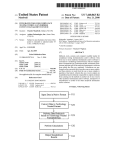
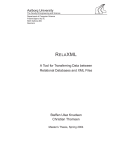

![Main lSetup l Cleanup] Parameters Locals}](http://vs1.manualzilla.com/store/data/005794368_1-f1180d1b21e5ef681561217b8f35e179-150x150.png)
